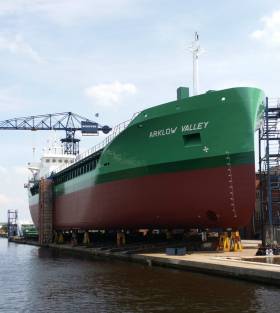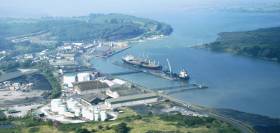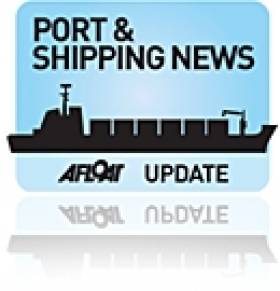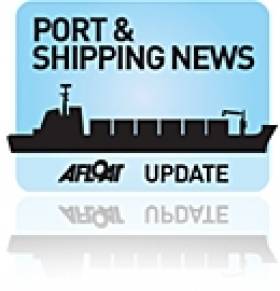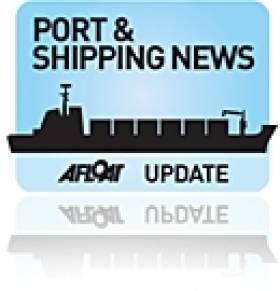Displaying items by tag: Port & Shipping News
Another Eco-Trader Newbuild for Arklow Becomes Third Valley
#ThirdValley - Another addition to Arklow Shipping’s latest series of newbuilds built by Royal Bodewes, a Dutch yard in north-east Netherlands, was launched this morning, writes Jehan Ashmore.
Yard no.724, Arklow Valley, a 5,150dwat Bodewes Eco-Trader (yard's own design), is the fourth so far completed out of an order of 10 single-hold cargoships. Likewise of her predecessor, Arklow Valiant, she differs to previous pair of sisters, Arklow’s Vale and View (leadship launch video), in terms of the bow design.
The distinctive energy-saving straight-stem designed bow slices the waves coupled by an upper slope to deflect wave resistance. In this aspect, the Eco-Trader series of Arklow Valley/ Valiant, still displays the same typical lines up to the main deck, but the bow lines above this level no longer show the backward inclination of Vale/View, but rather continue going straight up to the top.
The new design also provides an improved vision to the bow anchors while anchoring.
Arklow Valley was given the customary broadsides launch into the canal at Hoogezand and under clear blue skies.The yard near Gronignen, was not open to public for the launch, however they were welcomed to watch from the far side of the canal embankment as the 2,999 gross tonnage newbuild entered with a splash!
When the 86m Arklow Valley is delivered, she will be the 10th newbuild since 2014 for Dutch division, Arklow Shipping Nederland B.V.
This is the third ‘Valley’ cargoship of the ‘V’ class nomenclature series in the 50th year of Arklow Shipping. One has to go back to the early 1990’s when a ‘Valley’ has been on the fleetlist, this namesake was a 2,827gt low-air draft cargoship that featured a telescopic bridge. This design enabled the German (Weselsfleth) built vessel to pass under bridges on waterways to reach inland ports.
As for the original ‘Valley’, this was the Dutch 1977 (Foxhol-launched/Schiedam completed) cargoship, which was lengthened in 1980. Four years later, the 1,707gt cargoship became part of the Arklow fold, with outright ownership by ASL in 1987.
The Co. Wicklow company, headquartered on the banks of the River Avoca, Arklow, easily has the commanding position of Ireland’s largest privately owned merchant fleet of 30 ships. This excludes the Dutch division, in which Arklow Valley becomes their 18th Dutch-flagged vessel.
In total the combined fleets number 48 ships and appropriately, the Irish flagged cargohips are registered at their respective homeport of Arklow.
The ‘V’ class leadship, Arklow Valiant, launched in April also by Bodewes, arrived from Waterford to dock in Dublin Port this week where she remains berthed at Ocean Pier. Among the typical cargoes loaded at this berth is peat-moss.
Shannon Foynes Turnaround as 2015 Tonnages at Almost Peak of Last Decade
#ShannonGrowth - Tonnage growth at Ireland’s largest bulk port, Shannon Foynes Port Company (SFPC) revealed that the 2015 throughput was almost back to the peak of the last decade and this is evidence of the recovery taking hold in the regions.
SFPC handled just over 11.1m tons in 2015, up from just over 10.1million in 2014, and this comes off the back of a €2.8m profit recorded in its most recent annual accounts, for 2014. Tonnages in 2015 saw the company, which operates six ports on the Shannon Estuary and facilitates international trade valued at over €6bn, almost return to peak levels (11.35m tons) in 2006.
Announcing 2015 tonnages this week, SFPC said that the company is achieving the growth targets revealed three years ago with the launch of its masterplan, Vision 2041, and that this reaffirms the need for major investment in road and rail infrastructure to ensure its potential can be maximised. The tonnages also copper-fastens the company’s position as the largest dry bulk port in the country.
Cargo volumes last year at the SFPC general cargo terminals at Limerick and Foynes were particularly robust with 10.73% year on year growth. Among the key growth sectors were petroleum products tonnages, which increased by 7.4% and cement exports, which rose by over 200%. Agri related cargo also grew steadily, with trades such as fertilisers increasing by over 4%.
SFPC CEO Patrick Keating said, “This growth reflects the resurgence in the domestic and export economy and, of course, in our own business. SFPC is a really good economic indicator for the region. We had some challenging years but the turn-around in our business has been remarkable, to the extent that we are now almost replicating tonnages from the height of the last decade and expect to surpass those levels over the coming years.
“We are very confident about the potential of the Shannon Estuary as a major economic engine room for this region thanks to its unrivalled natural water depths. This year alone we have completed the biggest investment in quayside infrastructure in any Irish port so far this decade with the infill of our East Jetty, as part a wider €50m capital spend at Foynes. Our investment programme is also attracting significant private interest, with €40m in private investment also now coming on stream.”
SFPC Chairman Michael Collins also commenting on the port performance said, “SFPC is proving one of the great success stories of the recovery in this region. This impressive turnaround is very much down to a dynamic team and its determination to deliver the robust but attainable targets we have set for the company.
“Last year was another very solid year in terms of traffic throughput but future growth can only be sustained by delivering additional capacity and putting the road and rail infrastructure in place. If this doesn’t happen, the company’s potential to be a major engine for growth in this region will be curtailed.”
Dundalk Port Could be Controlled by Louth County Council
#DundalkPort- Dundalk Port could soon be controlled by Louth County Council following the signing of a bill by President Michael D Higgins on Christmas Day, reports The Talk of the Town.
The provision for the possible future transfer of the port from Dublin Port Company to the local authority was made as part of the Harbours Bill 2015, which came into force on December 25th.
The Harbours Bill 2015 provides the necessary legal basis for the transfer of ports to local authorities. Amongst the transfers that were made include Drogheda Port to Louth County Council while other ports that transferred as part of the Bill are Dún Laoghaire, Galway, New Ross and Wicklow.
Previously run by Dundalk Port Company, the local port as reported on Afloat had been run by Dublin Port Company since an amalgamation between the two companies in May 2011.
For further details on the control of the port, click here.
Newbuild: Arklow Bay’s 'Spectacular' Voyage Set in the Norwegian Fjords
#VoyageVideo - Arklow Bay, the second of six 'B' class cargoships with 'green' design credentials built for Arklow Shipping's Dutch subsidiary, is captured on video as she makes a spectacular passage through the stunning Norwegian fjords, writes Jehan Ashmore.
The speeded-up video footage courtesy of Chief Officer Lopatin, was taken last July from the Arklow Bay's bridge overlooking most her 119.49m hull. In fact the footage is made from thousands of photos made every 5-10 seconds and then combined into the film that follows her navigation through this stretch of Norway's vast rugged and mountainous coastline.
Channels dotted with islands are crossed by suspension bridges, inland lighthouses are trapped in fjords before the 'Bay' has finally reached her place of destination deep in the Nordic interior.
According to Lopatin, the 'Bay' berthed in Eikefet, to the north-east of Bergen, from where she made an en-route bunkering call albeit not shown on the video. With the ship berthed alongside the plant's jetty, watch the crew at work and as the deck gantry machinery opens the cargo hatch covers.
A conveyor-belt then gets into action to discharge stones that involves an overnight operation as the commercial world of shipping waits does not wait for anyone. In doing so, note the ship is shifted along the quayside pontoon in order to complete the loading into the separate holds from the fixed position of the conveyor.
Cargo holds filled, the Arklow Bay's work is done and she edges away from Eikefet at the foot of the mountain's cliff-face lined above with Alpine trees. Next port bound is Emden, Germany.
As she swings off the berth, another cargoship awaits to dock at the facility. Having 'ship-spotted' for many years, I recognised the vessel to be from the Bergen-based Wilson Fleet Management, a competitor of ASL that trades in the waters of north-western Europe.
To maintain market demand and ASL's track record of a running a modern 45-strong fleet of dry-cargoships, the 8,860 total deadweight Arklow Bay along with the final sixth sister (under construction) was contracted to Ferus Smit's Dutch yard.
The sleek streamlined 'bulb-less' hulled vessels will provide efficient cargo capabilities while on passage in varying sea-states compared to previous tonnage all since sold.
As previously reported on Afloat.ie, Arklow Bay, gave us another video spectacular!.... her sideways launch in Westerbroek in the 'lowlands' country.
Only months later, she would be operating in completely different surroundings with the backdrop of Scandinavian jaw-dropping peaks.
So this begs the question having also called to Dublin Port last October, where is the 'Bay' now?
ESPO Meets New EU Commissioner for Transport
#EUTransport - European ports work, they make transport work, make the economy work, make their environment work. That was the main message given by the European Sea Ports Organisation (ESPO) during their meeting today with the new EU Commissioner for Transport, Violeta Bulc.
Mrs Bulc met with ESPO Chairman, Santiago Garcia-Milà, ESPO Vice Chairs Eamonn O'Reilly (also Chief Executive of Dublin Port) and Annaleena Mäkilä and ESPO's Secretary General, Isabelle Ryckbost.
European port authorities need a policy that empowers them to successfully match commercial and public interests, and to meet the various challenges that both market forces and society imposes upon them.
Notwithstanding their diversity, European port authorities believe that more autonomy, be it commercial, financial and/or organisational will serve them best in facing the challenges ahead.
ESPO and the Commissioner exchanged views about the challenges ports are currently facing, and the vital role ports play for Europe's economy and growth.
In that respect, ESPO stressed that European ports are real drivers of economic prosperity and are to be seen as much more than a place where ships are simply loaded and unloaded.
Furthermore,the ESPO representatives outlined what European policy can do for ports and presented in that respect ESPO's recent memorandum, which highlights six points of attention for the new Commission and Parliament.
Finally, ESPO informed the Commissioner about its position regarding the port regulation proposal. ESPO stressed the importance of a EU ports policy that:
• Ensures full autonomy in setting charges and minimum requirements for port services
• Guarantees financial transparency where ports receive public funding
• Gives clear guidance on state aid for port investments.
ESPO Chairman Santiago Garcia-Milà asked for the support of the Commissioner on these points. "The Council has set important steps towards a more realistic and workable regulation. However, by letting Member States decide whether to give ports more autonomy or not, the Council risks to further undermine the level playing field between European ports. We want the autonomy of ports strengthened in Europe, as it was initially proposed by the Commission and is supported by the rapporteur in the European Parliament. We have asked Mrs Bulc to support us in that plea".
At the outcome of the meeting, ESPO's Secretary General Isabelle Ryckbost said: "We very much welcome the opportunity given by Commissioner Bulc for an open dialogue with ESPO and some of our members and we are very much honoured to have met Mrs Bulc early in her mandate. The Commissioner seems to understand both the diversity and potential of European ports. I am confident we can look forward to a constructive cooperation with the new Commissioner".
After the exchange of views with ESPO, the Commission also met with representatives of a selection of European ports for a two hour discussion on issues affecting the sector
ShortSea Conference 2015 to Be Held in Copenhagan
#ShortSea15 – The annual ESN Short Sea Shipping Conference 2015 will be taking place in Copenhagen for two days in June.
The European ShortSea Network is a co-operation between all national shortsea promotion centres. ESN has no legal status, but is an agreement between the members.
The ENS’s ShortSea conference is to be held between Thursday, 18 - Friday 19 June, and takes place at the CBS (Copenhagen Business School) in the Danish capital.
The organisers have arranged a Welcome Reception on Wednesday 17 June at 17:00.
If you are interested in attending and to register for the conference, further details are available by clicking HERE.
For further details to include a PDF download article about the conference, click this LINK.
#ChinaCoastalTrade - Three foreign-flag boxships owned by Cosco Container Lines according to LloydsLoadingList.com, have recently won government approval to carry containers between Shanghai and other Chinese ports.
The move signals an official launch of Beijing's pilot project to liberalise the country's cabotage restrictions.
The vessels, 49,961 dwt Cosco Surabaya, 49,973 dwt Cosco Venice and 49,959 dwt Cosco Wellington — all Hong Kong-flagged — are the first batch of players granted such privilege, while ships owned by China Shipping Container Lines are also applying for the designation, according to the state-run news agency Xinhua.
Beijing announced in 2013 that it would permit Chinese carriers to ship international cargoes between Shanghai and other Chinese ports with their own vessels flagged abroad after registering them in the transport ministry, under a pilot programme to boost transhipment in Shanghai free trade zone. The aim was to promote Shanghai, already the world's busiest port, as an international shipping centre.
For more on this trade development, click HERE.
Maersk Ship Sets World Record For Most Containers In Single Load
#Shipping - BusinessETC.ie brings our attention to this amazing video of the Maersk cargo vessel that's set a world record for the most containers carried on a single ship.
Brand new cranes were required at the Spanish port of Algeciras to load the Triple-E Mary Maersk, which departed for Malaysia on 21 July with an incredible 17,603 containers -- 20-foot equivalent units, or TEUs -- on board.
But even then the vessel set sail from Europe to Asia some 700 shipping containers short of its full capacity.
BusinessETC.ie has more on the story HERE.
#BelfastLough - A cargo ship that's been at anchor at the mouth of Belfast Lough for weeks may be allowed to dock at the harbour in the coming days, as the Belfast Telegraph reports.
The grain transporter Voge Fantasy was refused permission to enter Belfast Harbour due to concerns that the methods used to extinguish a fire in its hold four weeks ago produced toxic gases that could reignite the fire if opened.
Today (13 June) a final check on the affected parts of the vessel are being carried out, and if given the all clear she will be allowed to dock and unload her damaged cargo.
The Belfast Telegraph has more on the story HERE.
Centenary Old Ramsey Steamship Company Sells ‘Ben’ Coasters
#RamseySteamship – The historic Isle of Man shipping firm Ramsey Steamship Company has sold its two vessels Ben Maye (see 'Lockout' 1913 Voyage) and Ben Varrey to Angel Shipping Ltd.
The short-seas coasters will be operated and managed by a wholly-owned subsidiary of Angel, the Kent based Absolute Shipping Ltd.
As previously reported on Afloat.ie the Manx company announced it would be wound-up after 100 years because of a £1 million pensions liability.
Delivery of the re-liveried vessels took place in the vessels homeport of Ramsey this week, for more ManxRadio.com reports.


























